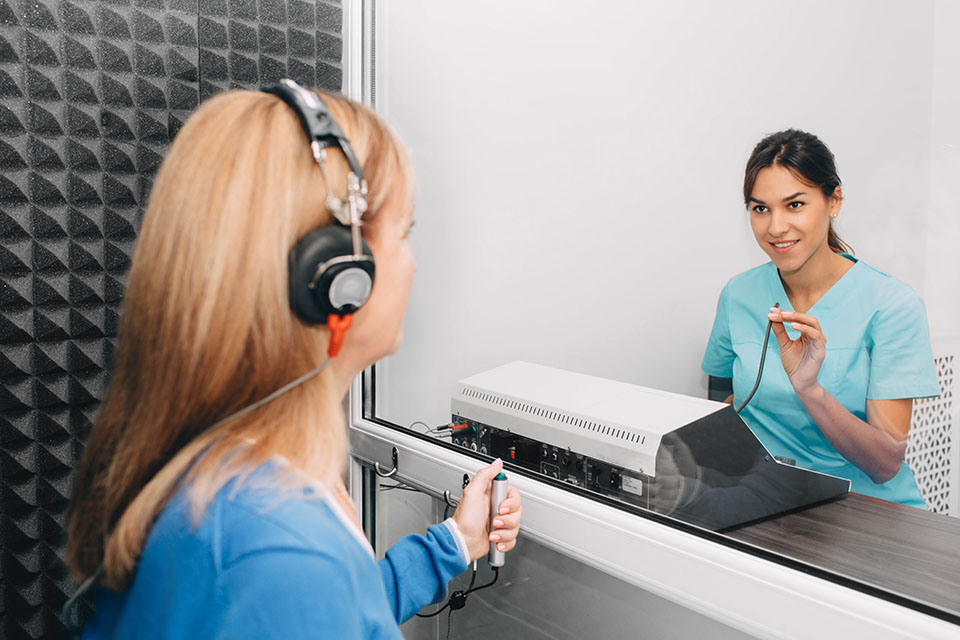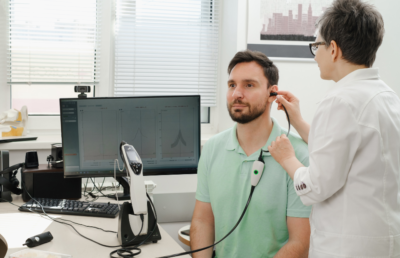A diagnostic hearing test is the first step on your way towards better hearing health. However, after you take your hearing exam results home, reading the audiogram chart that displays your results and understanding all the numbers and figures can be confusing. Here’s our comprehensive guide to help you understand the results of your hearing test to confidently take the next steps.
It’s important to regularly get your hearing checked as changes can occur at any point in life. At a hearing evaluation, your audiologist will explain your results, provide recommendations, and give you the opportunity to ask all your questions.
How to understand the results of your hearing test?
Firstly, let’s get a few important definitions out of the way.
- You might remember putting earphones on and signaling whenever you heard the “beep.” This is pure-tone testing that evaluates your hearing and degree of hearing loss.
- This testing produces a chart called an audiogram, which is a graph showing the softest sounds you can hear at different pitches or frequencies.
- The audiogram plots your hearing thresholds across various frequencies, or pitches, in a quiet listening environment. Hearing thresholds are defined as the lowest level sound that can be heard 50% of the time — so no need to worry if you feel like you missed some of the “beeps”.
- Frequency is the unit by which how high or low a sound is measured.
- Decibels are the unit by which sound is measured.
Your audiologist is interested in how loud the sound has to be before you respond. Simply put, they are measuring the softest sound you can hear. This is critical, as a hearing aid is tuned to make the sounds that cannot be heard louder, rather than just making all sounds louder. This is how your audiologist can help you find the device that’s just perfect for your personal needs.
How to read an audiogram?
For frequency, the audiogram can be read horizontally from left to right on the top. The lowest frequency tested is usually 250 Hertz (Hz), and the highest is usually 8000 Hz. Think of these like the keys on a piano where the sounds become higher pitched as you move from left to right.
For intensity or loudness of sound in decibels (dB), the audiogram can be read from up to down on the left, with the lowest levels at the top of the graph. Although the top left of the chart is labeled -10 dB or 0 dB, that does not mean the absence of sound. Zero decibels actually represents the softest level of sound that the average person with normal hearing will hear, for any given frequency.
What do the symbols on the graph mean?
The symbols represent the quietest level you responded to at each frequency during the hearing test.
- The responses from your left ear are represented in blue (X)
- The responses from your right ear are represented in red (O)
If the two lines are essentially overlapping, your hearing loss is considered symmetrical, or the same in both ears. If the lines are not overlapping, your hearing loss is considered asymmetrical, meaning your ears have differing degrees of hearing loss.
The degrees of hearing loss:
- Mild hearing loss: cannot hear sounds lower than 26 to 40 dB
- Moderate hearing loss: cannot hear sounds lower than 40-69 dB
- Severe hearing loss: cannot hear sounds lower than 70-94 dB
- Profound hearing loss: cannot hear sounds lower than 95 dB
Word testing
The pure tones on the audiogram are just one part of the hearing test. At Chicago Hearing Services, we also do a variety of word tests. These tests help confirm the hearing sensitivity results but also look at auditory processing. Word tests help the audiologists know about what hearing aids are best, if other treatment or management should be recommended, and can help set you up with realistic expectations. We perform word tests both in quiet and in noisy environments.
Can hearing aids help?
Combining both pure-tone thresholds are word testing results enabling an understanding of what it means to have a hearing loss and the likely resultant effectiveness of a hearing aid. So, is a hearing aid worth it? In most cases, a resounding “yes” is the answer as you can expect improved localization of sounds, awareness of sounds and improved understanding of speech from the hearing aid. However, it’s incredibly important to find a hearing aid that’s right for your needs.
Big-box retail stores may be great at selling items in bulk but diagnosing and properly treating hearing loss is an entirely different specialty. Plus, while they may be able to sell you a hearing aid that will get you a part of the way to hearing better, you can’t be sure that your hearing is being treated as well as it could be. Check out our exclusive guide on why it is worth it getting your hearing checked and diagnosed by an experienced audiologist!




